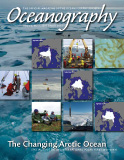First Paragraph
The Arctic Ocean is changing rapidly as Earth’s climate warms. To document and understand these changing ocean conditions, we developed a rosette that collects high-quality oceanographic data and is deployed from an aircraft through a 30.5 cm diameter hole drilled in the ice (Figure 1). The rosette is modular, with the modules attached vertically on a conducting hydrowire to achieve a small diameter. Typically, three modules with four 4-liter bottles each are positioned above the conductivity-temperature-depth (CTD) module (Figure 2). The rosette package is lowered through the ice and retrieved at speeds up to 40 meters per minute using a small winch mounted in the aircraft. The hydrowire leads from the aircraft to a sheave hung from a tripod on the ice above the hole inside a tent that is heated to prevent water samples and sensors from freezing (Figure 3). The CTD data are acquired and displayed in real time on a laptop computer, and bottles are closed at desired depths electronically. Upon recovery, each water-bottle module is immediately placed in a cooler with bags of snow, which provide thermal stability within ± 2°C of the in situ temperature. The modules are returned to a base camp where they can be sampled and the samples processed under controlled conditions. A wide variety of water samples can be collected. Thus far, we have collected samples for salinity, dissolved oxygen, nutrients, helium isotopes, oxygen isotopes, chlorofluorocarbons, SF6, tritium, CO2, barium, and 129I. The quality of all samples has been excellent. Smethie et al. (2011) provide a detailed description of the rosette and its performance.

